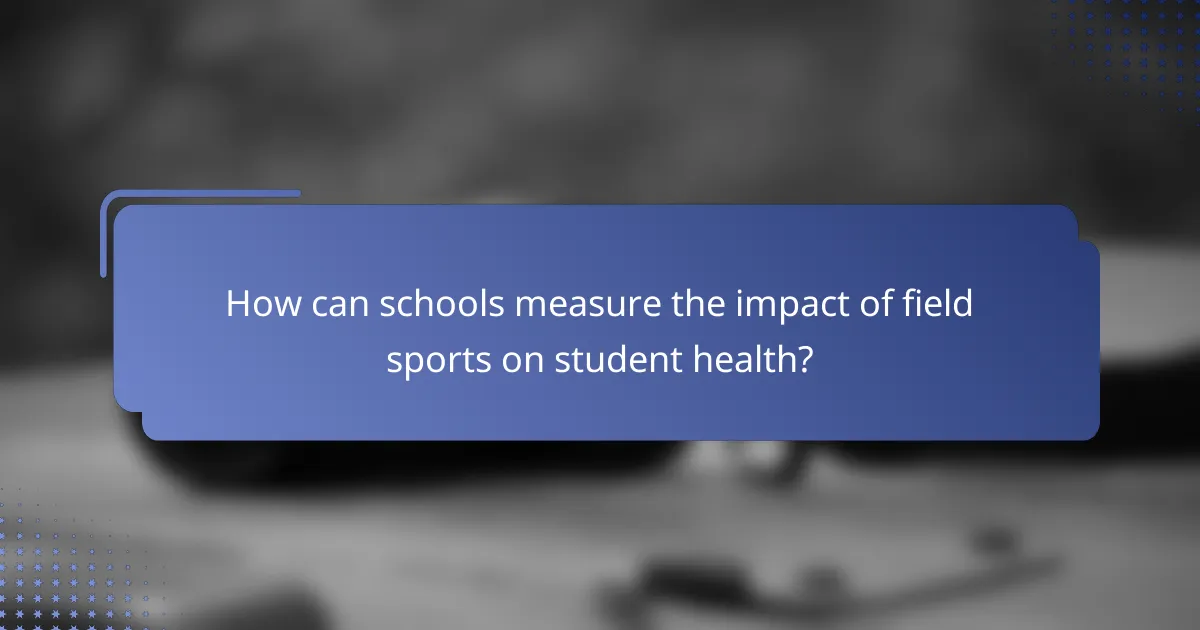Field sports play a crucial role in enhancing student engagement and promoting physical health within educational settings. By integrating these activities into the curriculum, schools can foster community, develop social skills, and encourage active participation among students. Additionally, field sports contribute to improved fitness levels and the establishment of lifelong healthy habits, aligning with broader educational goals.

How can field sports enhance student engagement in schools?
Field sports can significantly boost student engagement by fostering a sense of community and encouraging active participation. These activities not only make physical education more enjoyable but also help students develop essential social skills.
Increased teamwork and collaboration
Field sports inherently require teamwork, which cultivates collaboration among students. When participating in team sports, students learn to communicate effectively, strategize together, and support one another, building a strong sense of camaraderie.
For example, sports like soccer or basketball necessitate passing, positioning, and collective decision-making, which can translate into improved interpersonal skills in the classroom. Schools can facilitate this by organizing regular team practices and tournaments to enhance these collaborative experiences.
Improved physical fitness and health
Engaging in field sports promotes physical fitness, which is crucial for students’ overall health. Regular participation can lead to improved cardiovascular health, strength, and flexibility, contributing to a healthier lifestyle.
Schools can encourage participation by offering diverse sports options, such as track and field, rugby, or ultimate frisbee, catering to various interests and skill levels. Additionally, integrating fitness assessments can help students track their progress and set achievable health goals.
Boosted self-esteem and confidence
Participation in field sports can significantly enhance self-esteem and confidence among students. Achieving personal or team goals, such as scoring a point or winning a game, fosters a sense of accomplishment.
Schools should recognize and celebrate these achievements through awards or public acknowledgment, reinforcing positive self-image. Creating a supportive environment where students feel safe to take risks and learn from failures can further bolster their confidence in both sports and academics.

What are effective strategies for integrating field sports into the curriculum?
Effective strategies for integrating field sports into the curriculum include incorporating them into physical education classes, creating after-school sports programs, and partnering with local sports organizations. These approaches enhance student engagement and promote physical health while aligning with educational goals.
Incorporating sports into physical education classes
Integrating field sports into physical education classes can significantly boost student participation and interest in physical activity. Teachers should design lesson plans that include a variety of sports, ensuring that all students can find something they enjoy, from soccer to ultimate frisbee.
Consider using a rotational system where students can try different sports each week. This not only keeps the curriculum fresh but also helps students develop a broader range of skills. Incorporating assessments that focus on teamwork and sportsmanship can further enhance the learning experience.
Creating after-school sports programs
After-school sports programs provide additional opportunities for students to engage in field sports outside of regular class hours. Schools can offer a range of activities, from competitive teams to casual clubs, catering to different skill levels and interests.
To maximize participation, schools should promote these programs through newsletters, social media, and school assemblies. Offering incentives, such as awards or recognition for participation, can encourage students to join and stay active throughout the school year.
Partnering with local sports organizations
Collaborating with local sports organizations can enhance the quality and variety of field sports offered in schools. These partnerships can provide access to coaching expertise, facilities, and equipment that schools may not have on their own.
Schools should reach out to local clubs or community centers to explore partnership opportunities. Joint events, such as sports clinics or tournaments, can also foster community spirit and increase student engagement in physical health initiatives.

What role do field sports play in promoting physical health?
Field sports significantly contribute to physical health by enhancing fitness levels, reducing obesity, and fostering lifelong healthy habits among students. Engaging in these activities not only improves physical capabilities but also encourages a culture of health and wellness.
Enhancing cardiovascular fitness
Field sports are excellent for enhancing cardiovascular fitness, as they involve continuous movement and exertion. Activities like soccer, rugby, and field hockey elevate heart rates, promoting better circulation and overall heart health.
To maximize cardiovascular benefits, students should aim for at least 150 minutes of moderate-intensity activity each week, which can easily be achieved through regular participation in field sports. Incorporating interval training during practices can further boost cardiovascular endurance.
Reducing obesity rates among students
Participation in field sports plays a crucial role in reducing obesity rates among students by promoting physical activity and healthy lifestyle choices. Regular involvement helps burn calories and build muscle, which are essential for maintaining a healthy weight.
Schools can support this by offering a variety of field sports and ensuring that all students have access to equipment and facilities. Additionally, integrating physical education into the daily schedule can encourage consistent participation, further combating obesity.
Encouraging lifelong healthy habits
Field sports not only improve physical health but also instill lifelong healthy habits in students. Engaging in team sports fosters social connections and teaches important life skills such as teamwork, discipline, and resilience.
To encourage these habits, schools should create a supportive environment that emphasizes the importance of physical activity. Organizing community events or family sports days can also promote ongoing participation in sports beyond school years, reinforcing a commitment to health.

What are the prerequisites for successful field sports programs?
Successful field sports programs require a combination of adequate facilities, skilled coaching, and strong administrative support. These elements work together to create an environment conducive to student engagement and physical health.
Access to proper facilities and equipment
Access to suitable facilities and equipment is crucial for field sports programs. Schools should have well-maintained fields, courts, or tracks that meet safety standards and are appropriate for the sports offered. Additionally, necessary equipment like balls, nets, and protective gear must be available and in good condition.
When evaluating facilities, consider factors such as location, accessibility, and the ability to accommodate various sports. For example, a multi-sport field can serve soccer, rugby, and track events, maximizing usage and minimizing costs.
Qualified coaching staff
Having qualified coaching staff is essential for the success of field sports programs. Coaches should possess relevant certifications and experience in the specific sports they are teaching, ensuring they can effectively train and motivate students. This expertise helps in developing athletes’ skills while promoting safety and sportsmanship.
Schools may consider offering professional development opportunities for coaches to stay updated on best practices and new techniques. Engaging local sports clubs or organizations can also provide access to knowledgeable coaches who can enhance the program.
Supportive school administration
Support from school administration is vital for the sustainability of field sports programs. Administrators should prioritize funding for facilities, equipment, and coaching staff, as well as encourage student participation through promotional activities and events. A supportive environment fosters a culture of physical activity and teamwork.
Regular communication between coaches and administrators can help identify challenges and opportunities for improvement. Schools should also consider involving parents and the community in supporting field sports initiatives, as this can enhance resources and engagement.

How can schools measure the impact of field sports on student health?
Schools can measure the impact of field sports on student health through various methods such as fitness assessments, participation tracking, and student feedback. These approaches provide insights into physical health improvements, engagement levels, and overall satisfaction with sports programs.
Tracking fitness levels through assessments
Fitness assessments can include tests for cardiovascular endurance, strength, flexibility, and body composition. Schools may utilize standardized tests like the PACER test or sit-and-reach assessments to gauge student fitness levels before and after participation in field sports.
Regular assessments, conducted at the beginning and end of each term, can help in identifying trends in student health. Schools should aim for a minimum of two assessments per academic year to effectively monitor changes in fitness levels.
Analyzing participation rates
Participation rates in field sports can be tracked by recording the number of students enrolled in sports programs and their attendance at practices and competitions. Schools should aim for high participation rates, ideally above 70%, to ensure that a significant portion of the student body is engaged in physical activity.
Analyzing trends over time can reveal whether interest in field sports is growing or declining. Schools can compare participation rates across different sports to identify which activities are most appealing to students, allowing for targeted improvements in programming.
Gathering student feedback and surveys
Collecting feedback through surveys can provide valuable insights into students’ experiences with field sports. Schools can use anonymous surveys to ask students about their enjoyment, perceived benefits, and suggestions for improvement, ensuring a broad range of opinions is captured.
Surveys should be conducted at least once per academic year, with questions focused on aspects such as coaching quality, facilities, and overall satisfaction. Analyzing this feedback can guide schools in making informed decisions about enhancing their field sports programs.

What are the challenges of implementing field sports in urban schools?
Implementing field sports in urban schools presents several challenges, including limited space, resource constraints, and varying levels of student interest. These factors can hinder the effective integration of sports into the curriculum and impact student engagement.
Space limitations
Urban schools often face significant space constraints, making it difficult to provide adequate facilities for field sports. Many schools lack large outdoor areas or fields, which limits the types of sports that can be offered. Schools may need to consider alternative solutions such as utilizing nearby parks or community sports facilities.
Resource availability
Access to equipment and trained personnel is another challenge in urban schools. Budget limitations can restrict the purchase of necessary sports gear and the hiring of qualified coaches. Schools should explore partnerships with local organizations or seek grants to improve resource availability.
Student engagement
Engaging students in field sports can be difficult due to varying interests and levels of physical fitness. Some students may prefer individual activities or may feel intimidated by team sports. Schools can address this by offering a diverse range of sports and creating inclusive programs that cater to all skill levels.
Safety concerns
Safety is a critical consideration when implementing field sports in urban environments. Schools must ensure that facilities are safe and that students are educated on injury prevention. Regular maintenance of equipment and fields, along with proper supervision during activities, can help mitigate risks.
Community support
Building community support is essential for the successful implementation of field sports. Engaging parents, local businesses, and community organizations can foster a supportive environment. Schools should actively communicate the benefits of field sports and seek input from stakeholders to enhance program acceptance.



